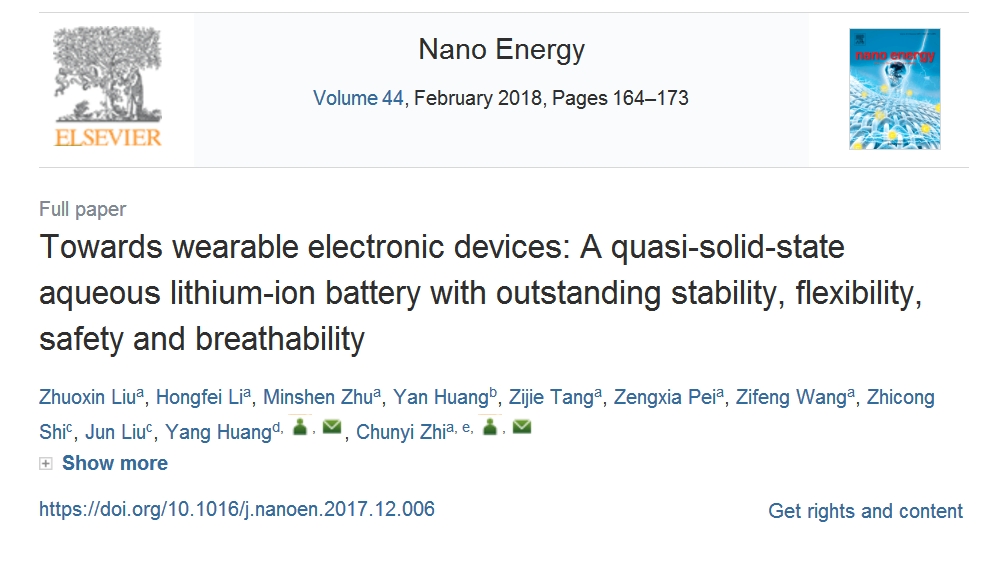2017-12-27
Recently, researchers from School of Materials Science and Engineering, Hong Kong City University developed a high-safety flexible aqueous lithium-ion battery. Related work has been published in the journal "Nano Energy" entitled "Towards wearable electronic devices: A quasi-solid-state aqueous lithium-ion battery with outstanding stability, flexibility, safety and breathability".

Since the inception, Lithium-ion battery is preferred by the people of all ages with its unique high-energy density, high output voltage and other advantages, it has been widely used in many electronic products. However, the frequent explosion of fire caused by branded mobile phones has drawn much attention to the safety of traditional organic lithium-ion batteries. Meanwhile, with the rise of smart wearable devices, the organic electrolyte of lithium-ion batteries is toxic and sensitive to humidity, it has also become an inevitable disadvantage. Therefore, the development of electrolyte with low toxicity and high safety has become the inevitable trend of the development of lithium-ion batteries.
Aqueous lithium-ion battery is a secondary battery with aqueous solution as electrolyte, which not only avoids the shortcommings like expensive, toxic, flammable of traditional organic battery electrolyte, but also overcome the harsh manufacturing process of organic battery production process and the strict control of water content, becoming one of the most promising green energy after wind energy and solar energy. However, in its development, it is also subject to some constraints, such as the stability of low-cost anode material lithium vanadate (LiV3O8).
Recently, the researchers from School of Materials Science and Engineering, City University of Hong Kong and Materials Science and Technology of Shenzhen University collaborated to improve the stability of lithium vanadate (LiV3O8) as a negative electrode in a water electrolyte by means of coating with PPy. With the stable LiMn2O4 positive electrode, flexible carbon cloth current collector, quasi-solid PVA/LiNO3 gel electrolyte, no additive of organic electrolyte (such as T3P, 1,3,6-Hexanetricarbonitrile), the high flexible, high-safety aqueous lithium battery was prepared. Under the current density of 0.5A•g-1, the aqueous lithium-ion battery could charge and discharge for 100 and 500 times, the capacity retention rate reached 98.7% and 79.8%. At the same time, the battery shows superb flexibility, safety, can be cut into any shape, and even holes in the battery body to increase its permeability, to better meet the requirements of wearing comfort.
As a new type of lithium ion battery, aqueous lithium ion battery has the advantages of high ion mobility, high rate charge and discharge, simplified equipment, safety, environmental protection, low cost, et al. It is a new generation of energy storage device with great potential for development and application. However, at present, there are still various problems in the development of aqueous lithium-ion batteries, which limits their development and commercialization. We believe through continuous research of researchers, the existing problems will be solved, to realize the commercialization of the aqueous lithium-ion battery.
Reference
Copyright © Suzhou Yacoo Science Co., Ltd. All Rights Reserved
Friendly Links :
online service